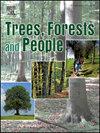Challenges for community-owned forests between traditional and new uses of forests: A Q-methodology study applied to an alpine case
IF 2.7
Q1 FORESTRY
引用次数: 0
Abstract
There is a worldwide increasing interest in forest ecosystem services (FESs), especially regulating and cultural ones. Providing FESs requires the shift towards a multifunctional forest management approach, and forest owners are key figures in this process. Current research on motivations and attitudes of forest owners towards provision of regulating and cultural FES focuses on non-industrial private forest owners but neglects community-owned forests, despite them being often innovative and multifunctional models of forest resource management. The paper explores the views of community-owned forest institutions to provide forest recreation. Sixteen cases have been studied in an alpine valley in Italy, where these institutions have been existing since hundreds of years. Q methodology was used. Q methodology is a semi-qualitative technique used to systematically analyze diverse points of view among individuals or groups by having them rank statements on a topic, allowing for the identification of similar views. Results show a general positive view of community-owned forest institutions towards providing recreation but with nuanced positions, which could be clustered in two groups. The first and largest group looked favourably at providing more forest recreation; the change towards forest recreation was however conditional to maintain adequate levels of income and receiving external support from public authorities. The latter and smaller group was more sceptical, being concerned about the potential negative impacts of visitors in the forest. Both groups stressed that sensitivity and respect of the visitors towards the property are decisive factors for accepting and improving public accessibility. The paper reflects on the challenges for these traditional forms of forest ownership in front of new societal demands, and concludes that, regarding forest recreation, the attitudes of community-owned forest institutions are not very different than those of other private forest owners.
社区拥有的森林在森林的传统用途和新用途之间面临的挑战:应用于高山案例的 Q 方法研究
全世界对森林生态系统服务 (FES) 的兴趣与日俱增,尤其是调节和文化服务。提供森林生态系统服务需要向多功能森林管理方法转变,而森林所有者是这一过程中的关键人物。目前有关森林所有者对提供调节性和文化性森林生态系统服务的动机和态度的研究主要集中在非工业化的私有森林所有者身上,却忽视了社区所有的森林,尽管它们通常是创新的多功能森林资源管理模式。本文探讨了社区拥有的森林机构对提供森林娱乐的看法。在意大利的一个高山峡谷中研究了 16 个案例,这些机构在那里已有数百年的历史。采用了 Q 方法。Q 方法是一种半定性技术,用于系统分析个人或群体的不同观点,方法是让他们对某一主题的陈述进行排序,从而找出相似的观点。结果显示,人们普遍对社区拥有的森林机构提供娱乐持积极态度,但也有细微差别,可分为两组。第一组,也是最大的一组,对提供更多的森林娱乐持积极态度;但转向森林娱乐的条件是保持足够的收入水平和获得公共当局的外部支持。而后一个规模较小的群体则持怀疑态度,担心游客在森林中可能产生负面影响。这两个群体都强调,游客对森林的敏感性和尊重是接受和改善公众可进入性的决定性因素。本文对这些传统形式的森林所有权在新的社会需求面前所面临的挑战进行了反思,并得出结论认为,在森林休闲方面,社区拥有的森林机构与其他私人森林所有者的态度并无太大区别。
本文章由计算机程序翻译,如有差异,请以英文原文为准。
求助全文
约1分钟内获得全文
求助全文
来源期刊

Trees, Forests and People
Economics, Econometrics and Finance-Economics, Econometrics and Finance (miscellaneous)
CiteScore
4.30
自引率
7.40%
发文量
172
审稿时长
56 days
 求助内容:
求助内容: 应助结果提醒方式:
应助结果提醒方式:


